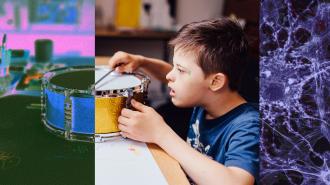Music has quickly become a tool used in various therapies because it can stimulate both hemispheres of our brain rather than just one. Theoretically, a therapist could use a song or instrument to support cognitive activity that helps children with autism build self-awareness and improve their relationships with others.
Music encourages communicative and social behaviors
According to Nurse Journal, “…if we look closely at the way that a band works, it is obvious that the instruments must all interact with one another, but the player only needs to interact with the instrument at first.”
This can be particularly difficult for children dealing with autism, but by introducing an instrument to their therapy, they may first bond with the object itself and then open up to interacting with others through the use of their instrument.
Music also encourages a better understanding of words and actions
For children with autism, listening to a song about brushing their teeth could help them learn how to do this activity. Autism can create barriers for children in social settings, but small groups of children listening to music together may help the child feel comfortable singing or expressing themselves in front of others. According to research, dancing exercises in songs also help stimulate the sensory systems, allowing the children to enhance their fine motor skills.
The positive impact of music goes beyond social interactions, helping children develop better motor skills and body awareness
According to a 2004 study published in the Journal of Music Therapy, music intervention used with children and teens with ASD (autism spectrum disorder) can improve their social behaviors, increase focus and attention, increase communication attempts (vocalizations, verbalizations, and gestures), reduce their anxiety, and improve body awareness. A more recent 2018 study showed similar results.
Music is used in many different therapies. Used in conjunction with traditional therapies, music therapy benefits us in a variety of different ways.
According to Positive Psychology, some of the major health benefits of music therapy include:
- Reduces anxiety and physical symptoms of stress
- Helps to manage Parkinson’s and Alzheimer’s disease
- Reduces depression and other symptoms (in the elderly population)
- Reduces symptoms of psychological disorders
- Improves self-expression and communication
The Nordoff-Robbins approach to music therapy
This approach to music therapy interventions was developed through the 1950s-1970s by Paul Nordoff (an American composer and pianist) and Clive Robins (a teacher of children with special needs). According to Positive Psychology, this is an approach designed to harness every person’s potential for engagement through active, communicative, and expressive music-making.
This approach emphasizes the importance of music-making in developing skills, a sense of self, and a capacity for social interactions. Nordoff and Robins both believed that all people, regardless of pathology, illness, disability, or trauma all have the ability to make music. Due to Robins’ history with teaching children, this specific approach is well known for its work with children and adults who have learning disabilities or difficulties.
Relaxation music therapy
Research has proven music aids in muscle relaxation. This can enable you to easily release some of the tension in your body, and when you do this, your mind also relaxes. While this is particularly useful for adults, it can also be beneficial for children. Music can be used as stress relief when a child with autism begins to feel overwhelmed in a new situation. Positive Psychology also explains that music therapy for children can also aid in offering a rhythmic structure for relaxation and breathing.
Music therapy for children
What does music therapy look like for young children? Music therapy will vary based on each individual child’s needs and abilities. For some, it can mean learning to play a musical instrument and for others, it can be singing or learning new activities through songs. Various music therapy activities and tools can be used (discussed and decided upon by both parents and therapists) to help improve the quality of life of children with autism.
This article was reprinted with permission of Big Think, where it was originally published.





